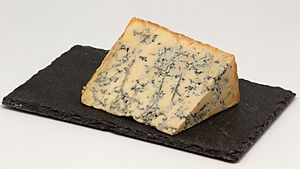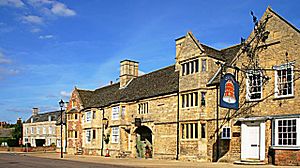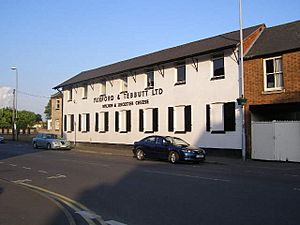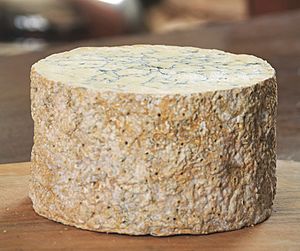Stilton cheese facts for kids
Quick facts for kids Stilton |
|
|---|---|

Blue Stilton
|
|
| Country of origin | England |
| Region, town | Derbyshire, Leicestershire, and Nottinghamshire |
| Source of milk | Cows |
| Pasteurised | Yes |
| Texture | semi-soft, crumbly, creamier with increasing age |
| Aging time | 9 weeks minimum |
| Certification | PDO |
| Named after | Lua error in Module:Wikidata at line 70: attempt to index field 'wikibase' (a nil value). |
Stilton is a famous English cheese. It comes in two main types: Blue Stilton and White Stilton. Blue Stilton has a special mould called Penicillium roqueforti added to it. This mould gives it its unique smell and strong taste. White Stilton is the same cheese, but without this mould.
Both types of Stilton cheese have a special status called a Protected Designation of Origin (PDO). This means the cheese must be made in a very specific way. It can only be produced in three counties in England: Derbyshire, Leicestershire, or Nottinghamshire. Interestingly, cheese made in the village of Stilton itself, which is now in Cambridgeshire, cannot be called "Stilton" cheese.
Contents
History of Stilton Cheese
People have been making cheese similar to Stilton for a long time. A cheese maker named Frances Pawlett from Wymondham, Leicestershire, is often given credit for shaping modern Stilton cheese in the 1720s.
The Stilton Cheesemaker's Association says that Cooper Thornhill was the first person to sell Blue Stilton widely. He owned the Bell Inn, a famous hotel, in the village of Stilton. This village was on the Great North Road, a main travel route from London to the north of England.
The story goes that in 1730, Thornhill found a special blue cheese while visiting a farm near Melton Mowbray. He loved the cheese so much that he made a deal. His inn got the special right to sell Blue Stilton. Because many stagecoaches passed through Stilton village, he was able to sell a lot of cheese to travelers.
In 1936, the Stilton Cheesemakers' Association (SCMA) was created. They wanted to protect the quality and origin of the cheese. In 1966, Stilton became the only British cheese to get special legal protection as a trade mark.
How Stilton Cheese is Made
Blue Stilton gets its famous blue veins from a special process. Workers carefully poke holes in the cheese's crust with stainless steel needles. This lets air get inside the cheese. The cheese then ripens for about nine to twelve weeks. During this time, the blue mould grows along the air channels.
For a cheese to be called "Stilton," it must follow strict rules:
- It must be made in one of the three counties: Derbyshire, Leicestershire, or Nottinghamshire.
- It must use pasteurised milk from cows in the local area.
- The cheese makers applied for and received protection under European Law in 1996. This is the PDO status mentioned earlier.
There's a cheese called Stichelton that is made very much like Stilton. It uses milk from Nottinghamshire cows. However, the milk is unpasteurised (not heated to kill germs). Because of this, it cannot be called "Stilton" under the PDO rules.
As of 2016, only six dairies are allowed to make Stilton cheese. These dairies are checked by independent inspectors to make sure they follow all the rules. Most of these dairies are in the Vale of Belvoir, an area that crosses the border between Nottinghamshire and Leicestershire. This area is known as the main place where Stilton is made.
It's important to remember that Stilton cheese cannot be made in the village of Stilton itself. This is because the village is not in the three counties where Stilton cheese is allowed to be made.
What Makes Stilton Special
To be called "Blue Stilton," a cheese must meet several requirements:
- It must be made only in Derbyshire, Leicestershire, or Nottinghamshire using local, pasteurised milk.
- It must have the traditional cylindrical shape.
- It must form its own natural crust.
- It must not be pressed during its making.
- It must have blue veins spreading out from its center.
- It must taste like a typical Stilton cheese.
- It must have at least 48% milk fat in its dry matter.
Stilton cheese usually has about 35% fat and 23% protein.
Cheeses Similar to Stilton
Many blue cheeses are made in a similar way to Blue Stilton. These cheeses get their blue veins and strong taste from special fungi, like Penicillium roqueforti. Since the PDO rules came in, some British supermarkets sell a general "British Blue cheese." Other cheese makers have created their own names and styles. Some other well-known British blue cheeses include Oxford Blue and Shropshire Blue.
Blue cheeses are made all over the world. Italy has Gorgonzola, a greenish-blue cheese made from cow's milk. France has Fourme d'Ambert and Roquefort, which is made from ewe's milk. Denmark makes Danish Blue Cheese, and the Netherlands makes Ruscello.
How to Enjoy Stilton
Blue Stilton is often eaten with celery or pears. You can also add it to vegetable soup, like cream of celery or broccoli soup, for extra flavor. It's also great with crackers, biscuits, or bread. Some people use it to make a blue cheese sauce to pour over a steak, or crumble it over a salad. Stilton cheese is a traditional food eaten around Christmas time. The outer skin, or rind, of the cheese forms naturally as it ages.
White Stilton is the same cheese as Blue Stilton, but it doesn't have the Penicillium roqueforti mould added. It is a crumbly, creamy cheese with an open texture.
Stilton and Dreams
In 2005, a survey by the British Cheese Board found something interesting about Stilton. It seemed to cause unusual dreams! The survey reported that 75% of men and 85% of women had "odd and vivid" dreams after eating a small piece of Stilton about half an hour before going to sleep.
Stilton in Culture
The famous writer George Orwell wrote an essay in 1945 called "In Defence of English Cooking." In it, he praised British foods and said, "Then there are the English cheeses. There are not many of them, but I fancy that Stilton is the best cheese of its type in the world..."
The Stilton Cheese Makers Association even created a perfume called Eau de Stilton. They said it was "very different to the very sweet perfumes you smell wafting down the street."
Images for kids
See also
 In Spanish: Stilton para niños
In Spanish: Stilton para niños






